Mahdi M. A. Shamad1, Neama Motasem Abdelhai2, Nawaf AlMutairi3
1College of Medicine, University of Bahri, Sudan
2Khartoum Dermatology and Venereology Teaching Hospital, Khartoum, Sudan
3Faculty of Medicine, Kuwait University, Kuwait
Correspondence to: Mahdi M. A. Shamad, College of Medicine, University of Bahri, Sudan.
| Email: |  |
Copyright © 2025 The Author(s). Published by Scientific & Academic Publishing.
This work is licensed under the Creative Commons Attribution International License (CC BY).
http://creativecommons.org/licenses/by/4.0/

Abstract
Post-acne scarring is a common and well-known sequelae of acne vulgaris. Scarring on visible areas such as the face is associated with negative psychological impact. Many patients with acne have clinically relevant scarring for which they seek treatment, implying that there is an impact on their lives. Objective of this study is to determine the quality of life among females of skin of color with post-acne scar. This hospital-based, descriptive, cross-sectional study, was conducted in Khartoum dermatology and venereology hospital, Sudan, between August 2021 and January 2022. A total of 70 females with Fitzpatrick skin types IV to VI with facial post-acne scars presented during the study period and considered as the study population. Among 70 patients with post-acne scar, 65.7% had moderate type, 18.6% had mild, and 15.7% had severe scars. The study reported that the most common type of atrophic post-acne scar is boxcar, followed by ice pick and rolling scar. The study reported that 85.7% of patients felt self-conscious, annoyed or sad because of acne scar, 82.9% felt less attractive, 74.3% worried about scars not going away, 70% upset by negative comments from others, 67.1% bothered by having to hide acne scar and spend time putting make-up on, 35.7% avoid going out, 27.1% their relationship with others is affected by acne scar and 27.1% their participation at work or school is affected. In conclusion acne scars have a substantial negative impact on the overall social and functional well-being of affected individuals.
Keywords:
Acne scar, Post-acne scar, Quality of life, Skin of color
Cite this paper: Mahdi M. A. Shamad, Neama Motasem Abdelhai, Nawaf AlMutairi, The Impact of Facial Atrophic Post-Acne Scars on the Quality of Life in Skin of Color, American Journal of Medicine and Medical Sciences, Vol. 15 No. 2, 2025, pp. 314-317. doi: 10.5923/j.ajmms.20251502.10.
1. Introduction
Acne vulgaris is a common skin disease that affects over 90% of adolescents, in approximately 12-14% of cases may continue till adulthood with association of psychological consequences [1]. Affected sites by acne are related to the concentrations of pilosebaceous glands, thus the commonest affected areas include the face, shoulder, chest and back [2]. Post-acne scar was declared by the world health organization that it can cause residual disability and must be considered a serious illness that interferes the productivity of society [3].Post-acne scarring can remain for life acting as a visible reminder of the disease [4]. Early management of acne vulgaris is crucial in preventing post-acne scarring and so the consequent adverse psychosocial disabilities [5]. Post-acne facial scars have been shown to cause high level of anxiety and self-consciousness [6]. Acne scarring has long been linked to depression and has been identified as a risk factor for suicide [7]. People who develop post-acne scars believe their look interferes with their professional connections and future work prospects [8].Among people with post-acne scars some have scars associated with a loss of collagen (atrophic scars) and others may develop hypertrophic scars and keloids (more commonly seen on the chest and shoulders) [1]. Atrophic scars are further sub devided into: ice pick, rolling and boxcar [9]. Post-acne scars impose a considerable burden for patients, and they are presumed to have a negative impact on their social life [10]. Acne scar affects the quality of life of people with skin of color adversely resulting from emotional debilitation, embarrassment, poor self-esteem, social isolation, altered social interactions, anger, frustration, low confidence, unemployment, lowered academic performance, anxiety, depression and exacerbation of psychiatric disease [10]. Few researches have been conducted on the psychological impacts of post-acne scarring in affected individuals, and even fewer have examined how it affects people with skin of color in terms of their quality of life. These people with acne scars have emotional problems that must be identified and properly addressed.This study aims to determine the impact of post-acne scars on the quality of life in female with skin of color.
2. Material and Methods
This hospital-based, descriptive, cross-sectional study, conducted in Khartoum dermatology and venereology hospital, Sudan, between August 2021 and January 2022. A total of 70 adolescents and adult females with Fitzpatrick skin types IV to VI with facial post-acne scars presented during the study period and considered as the study population. Ethical clearance was obtained from the relevant bodies, privacy of data collected was considered, and written informed consent was obtained from tall participants. Then, all participants were subjected to clinical examination of facial lesions and results were recorded in a specially designed questionnaire. As to determine the content validity of questionnaire items, it was tested by a pilot study of randomly selected sample of 20 patients. To improve the reliability of the questionnaire, any inconsistency or confusion in the questions were adjusted.The data were analysed using Statistical Packages for Social Sciences (SPSS) version 23.0 software with Chi-square test, as appropriate P<0.05 is considering statistically significant (Confidence Interval: CI 95%).
3. Results
All 70 patients with acne scar participated in this study were skin type IV or V. The study revealed that the majority of patients 46 (65.7%) had moderate acne scar, 13 (18.6%) had mild acne scar, 11 (15.7%) had severe acne scar.Concerning quality of life, results showed that 85.7% of patients felt annoyed because of post-acne scar [table 1], 82.9% felt less attractive [table 2], and 74.3% worried about scars not going away [table 3]. Concerning relation with others, 70% are upset by negative comments from others [table 4], 35.7% avoid going out [table 5], 67.1% bothered by having to hide acne scar and spend time putting make-up on [table 6], 27.1% their relationship with others is affected by acne scar [table 7] and 27.1% their participation at work or school is affected [table 8]. Table 1. Post-acne patients who felt annoyed by the scar
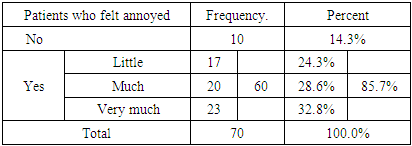 |
| |
|
Table 2. Post-acne patients who felt less attractive by the scar
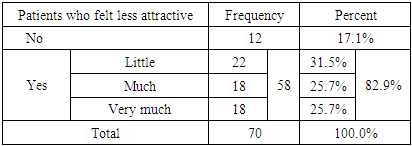 |
| |
|
Table 3. Post-acne patients who felt worried that the scar won’t go away
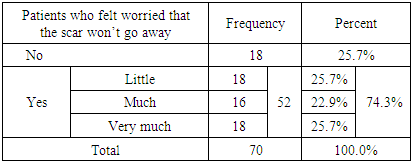 |
| |
|
Table 4. Post-acne patients who felt upset by negative comments from others
 |
| |
|
Table 5. Post-acne patients who avoid going out
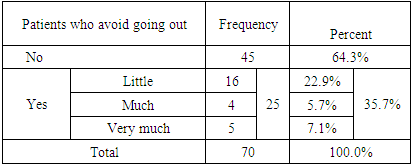 |
| |
|
Table 6. Post-acne patients who felt bothered by having to hide acne scar
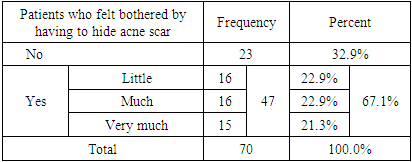 |
| |
|
Table 7. Effect of post-acne scars on patient’s relationship with others
 |
| |
|
Table 8. Effect of post-acne scars on patient’s participation at work or school
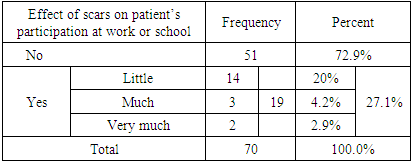 |
| |
|
In this study the relation between patients who felt annoyed because of post-acne scar and the grade of acne scar is insignificant (p-value = 0.092) [table 9], and the relation between effect of acne scar on patient’s participation at work or school with grade of post-acne scar is also insignificant (p-value = 0.933) [table 10].Table 9. Relation between grade of post- acne scar and feeling annoyed because of the scar
 |
| |
|
Table 10. Relation between grade of post- acne scar and participation at work or school
 |
| |
|
4. Discussion
Skin disease can have profound and long-lasting impact on those affected. While many with acne scars seek treatment, little is known about the impact of this condition especially on patients with skin of color. Atrophic acne scarring in skin of color is a common result of uncontrolled acne vulgaris. Acne scars are typically assumed to negatively affect patient's quality of life [10]. Results of this study showed that post-acne scar affected the quality of life by making patients annoyed, felt less attractive, worried about scars not going away, upset by negative comments from others, bothered by having to hide acne scar and spend time putting make-up on. To less percentage, the patients avoid going out, and their relationship with others is affected by acne scar and more over their participation at work or school is affected. These results are similar to the study done in Singapore (5) which illustrated that 36% of patients were self-conscious, 24% felt that their acne scar was affecting their social activities and in 18% interfered with them going out or shopping [5]. Results are also similar to a study done in USA which reported the following: feeling less attractive (83.3%), feeling self-conscious (66.6%), low confidence (10, 33.3%), annoyed (33.3%), think their scars will not disappear (30.0%), feeling depressed (26.6%), irritated from people comments (33.3%), avoiding or changing social activities (23.3%), upset about trying to hide scars (23.3%), and impacts to work/school life (26.6%) [11]. A different study conducted in the United States likewise produced similar results, finding that 68.8% feeling less happy about own body, 71.9% less happy when the face is touched, 80.2% less confident, 84.4% less attractive and most notably, feeling less happy when looking in mirror 85.4% [12].
5. Conclusions
This study showed that post-acne scar is a health problem in adolescents and adults with skin of color, with considerable impact on their quality of life.
6. Recommendations
As to helping patients with post-acne atrophy regain confidence and enjoy life, here are some techniques:1. Building self-confidence by cognitive restructuring, challenge negative self-talk, and positive affirmations.2. Strengthening emotional resilience by exposure therapy, such as gradual exposure to social situations to reduce anxiety about their appearance. Also, by meditation to reduce stress and negative emotions tied to appearance concerns.3. Joining therapy or support groups as to be engaged with others who have similar experiences can reduce feelings of isolation.4. It is also important to look for any available medical or procedural treatment for the post-acne scars, if possible, this may be the most crucial and definite technique to get confidence and restore self-esteem.
References
| [1] | Fabbrocini G, Annunziata MC, D'Arco V, De Vita V, Lodi G, Mauriello MC, Pastore F, Monfrecola G. Acne scars: pathogenesis, classification and treatment. Dermatol Res Pract. 2010; 2010: 893080. doi: 10.1155/2010/893080. |
| [2] | Kravvas G, Al-Niaimi F. A systematic review of treatments for acne scarring. Part 1: Non-energy-based techniques. Scars Burn Heal. 2017 Mar 30; 3: 2059513117695312. Doi: 10.1177/2059513117695312. |
| [3] | Hayashi N, Miyachi Y, Kawashima M. Prevalence of scars and "mini-scars", and their impact on quality of life in Japanese patients with acne. J Dermatol. 2015 Jul; 42(7): 690-6. Doi: 10.1111/1346-8138.12885. |
| [4] | Dréno B, Tan J, Kang S, Rueda MJ, Torres Lozada V, Bettoli V, Layton AM. How People with Facial Acne Scars are Perceived in Society: an Online Survey. Dermatol Ther (Heidelb). 2016 Jun; 6(2): 207-18. Doi: 10.1007/s13555-016-0113-x. |
| [5] | Sai Yee Chuah, Chee Leok Goh. The Impact of Post-Acne Scars on the Quality of Life Among Young Adults in Singapore. J Cutan Aesthet Surg. 2015 Jul-Sep; 8(3): 153–158. |
| [6] | Brown BC, McKenna SP, Siddhi K, McGrouther DA, Bayat A. The hidden cost of skin scars: quality of life after skin scarring. Journal of Plastic, Reconstructive & Aesthetic Surgery 2008 Sep; 61(9): 1049-58. Doi: 10.1016/j.bjps.2008.03.020. |
| [7] | Cotterill JA, Cunliffe WJ. Suicide in dermatological Patients. Br J Dermatol. 1997; 137: 246–50. |
| [8] | Zhou C, Vempati A, Tam C, Khong J, Vasilev R, Tam K, Hazany S, Hazany S. Beyond the Surface: A Deeper Look at the Psychosocial Impacts of Acne Scarring. Clin Cosmet Investig Dermatol. 2023 Mar 25; 16: 731-738. Doi: 10.2147/CCID.S406235. |
| [9] | Jacob CI, Dover JS, Kaminer MS. Acne scarring: a classification system and review of treatment options. J Am Acad Dermatol. 2001 Jul; 45(1): 109-17. doi: 10.1067/mjd.2001.113451. |
| [10] | Tan J, Beissert S, Cook-Bolden F, Chavda R, Harper J, Hebert A, Lain E, Layton A, Rocha M, Weiss J, Dréno B. Impact of Facial Atrophic Acne Scars on Quality of Life: A Multi-country Population-Based Survey. Am J Clin Dermatol. 2022 Jan; 23(1): 115-123. |
| [11] | Layton A, Dréno B, Finlay AY, Thiboutot D, Kang S, Lozada VT, Bourdès V, Bettoli V, Petit L, Tan J. New Patient-Oriented Tools for Assessing Atrophic Acne Scarring. Dermatol Ther (Heidelb). 2016 Jun; 6(2): 219-33. doi: 10.1007/s13555-016-0098-5. |
| [12] | Richard G. Fried, Phil Werschler, Diane Berson, James Q. Del Rosso. The Psychosocial Impact of Post-Acne Scarring. The Dermatologist Sebtember 2015; 23(9): online. |



 Abstract
Abstract Reference
Reference Full-Text PDF
Full-Text PDF Full-text HTML
Full-text HTML








